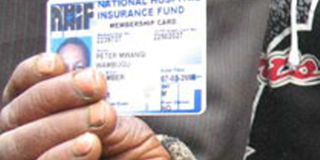Queries raised on NHIF plan for students

An NHIF card. Kenyans have reacted after the government issued a directive that secondary school students be covered by NHIF from January 2018. PHOTO | FILE | NATION MEDIA GROUP
What you need to know:
- But the move has been questioned based on the current contribution matrix used by the State insurer.
- Kenya was picked among 10 other countries to pilot roll out of Universal Health Coverage at the Universal Health Coverage Forum in Japan.
A directive by President Uhuru Kenyatta to the Health and Education ministries to enrol three million secondary school students for the National Hospital Insurance Fund (NHIF) has raised questions.
In the announcement made on Wednesday by the President, the plan is expected to kick off in January next year across schools.
“As part of the President’s big four growth agenda, President Kenyatta directed Matiang’i (Education Cabinet Secretary Fred) to work with the Ministry of Health to enrol all three million secondary school students into the NHIF programme,” the statement sent to newsrooms stated.
But the move has been questioned based on the current contribution matrix used by the State insurer.
FUNDING
It is not clear how the NHIF will be funded should the children be enrolled as it currently runs on two funding models where those in the formal sector contribute Sh1,700 through compulsory membership while those in the informal sector and retirees pay Sh500 in an open and voluntary plan.
As currently constituted, principal members to the fund can only be above 18 years old.
This is because for one to be eligible for membership, they ought to not only be 18 but also have a national identity card.
CRITICISM
This, therefore, means that secondary school children cannot individually be enrolled for NHIF as most are still below this age and are still covered under a principal contributor, who is a parent or guardian.
Most Kenyans who took to social media criticised the plan.
“There are thousands of Kenyans who cannot afford to pay the Sh500 monthly fee to NHIF hence missing out on proper health care.
"Why are they not being given priority because, when you cover a parent, most definitely the children are taken care of?” Mr Richard Otieno, a Kisumu resident, asked.
CONSULTATION
Mr Ken Mwaura, another social media user, termed the move a bad decision.
“Cover three million parents and you will have covered their spouses and four children at the same premium.”
Carnegie Dale Jidzi asked: “Who will pay for all these freebies? Are we making Kenyans lazy and irresponsible by having too many free things?
"The time has come for leaders to consult widely, even if through public participation, before making critical decisions.”
But others supported the move. Duncan Prezzay Okombo said: “That’s great news. Now he should put down measures to ensure no money is lost.”
Florence Nyambura Waichigo: “To the critiques...how many Kenyans pay NHIF? It’s not compulsory remember and so covering all the students is a wise move....very.”
Kim Kinoti said the usual critics are complaining that parents cover their children, yet many Kenyans cannot afford NHIF. “Are all parents enrolled in NHIF? Are all students below 18 years?” he questioned.
AGENDA
The President recently announced that his government will put emphasis on four key areas, among them food security, inexpensive health care, affordable housing and manufacturing during his final term.
To achieve 100 per cent universal health care coverage for all households by 2022, the government announced it would undertake major policy and administrative reforms in health.
Kenya was picked among 10 other countries to pilot roll out of Universal Health Coverage at the Universal Health Coverage Forum in Japan.





